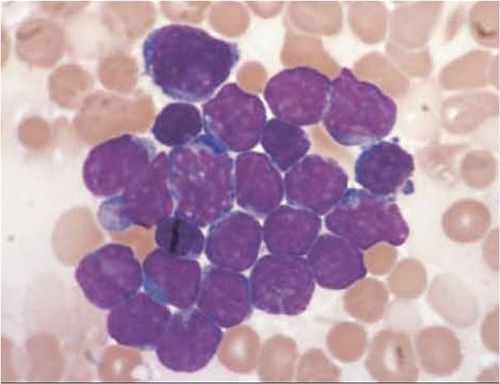Difference between revisions of "Cytology Q&A 03"
Ggaitskell (talk | contribs) (Created page with "{{Template:Manson}} centre|500px <br /> '''A nine-year-old three quarter-bred hunter was running badly. Excessive fluid was identified in the pleural space. ...") |
|||
| Line 18: | Line 18: | ||
|a2= | |a2= | ||
There is a mixed cell population. The cells are pleomorphic round cells showing anisocytosis and anisokaryosis. The large nuclei and thin rims of cytoplasm suggest they are of lymphoid origin. The cytoplasm is intensely basophilic. The nuclei have irregular borders and clumped chromatin, and nucleoli are present in some. The cells are considered to be neoplastic lymphocytes. | There is a mixed cell population. The cells are pleomorphic round cells showing anisocytosis and anisokaryosis. The large nuclei and thin rims of cytoplasm suggest they are of lymphoid origin. The cytoplasm is intensely basophilic. The nuclei have irregular borders and clumped chromatin, and nucleoli are present in some. The cells are considered to be neoplastic lymphocytes. | ||
| − | |l2= | + | |l2=Lymphoma - Cytology |
|q3=What is your diagnosis? | |q3=What is your diagnosis? | ||
|a3= | |a3= | ||
Lymphosarcoma. The horse was euthanased and lymphosarcoma was confirmed on postmortem examination. | Lymphosarcoma. The horse was euthanased and lymphosarcoma was confirmed on postmortem examination. | ||
| − | |l3= | + | |l3=Lymphoma - Cytology#Equine Lymphoma |
</FlashCard> | </FlashCard> | ||
Revision as of 10:40, 9 August 2011
| This question was provided by Manson Publishing as part of the OVAL Project. See more [[:Category:{{{book}}}|{{{book}}}]]. |
A nine-year-old three quarter-bred hunter was running badly. Excessive fluid was identified in the pleural space. A sample of fluid was withdrawn; it was light yellow and clear, and had an NCC of 5.5 × 109/l and a TP of 24 g/l. A cytospun smear of pleural fluid contained a mixed cell population including erythrocytes, neutrophils, macrophages and mesothelial cells, and many clusters of cells (Wright–Giemsa, ×100 oil).
| Question | Answer | Article | |
| How would you classify the fluid? | The fluid is a modified transudate, as the NCC and TP values are within the ranges usually seen for this type of fluid. |
Link to Article | |
| What are the cells shown? | There is a mixed cell population. The cells are pleomorphic round cells showing anisocytosis and anisokaryosis. The large nuclei and thin rims of cytoplasm suggest they are of lymphoid origin. The cytoplasm is intensely basophilic. The nuclei have irregular borders and clumped chromatin, and nucleoli are present in some. The cells are considered to be neoplastic lymphocytes. |
Link to Article | |
| What is your diagnosis? | Lymphosarcoma. The horse was euthanased and lymphosarcoma was confirmed on postmortem examination. |
Link to Article | |
